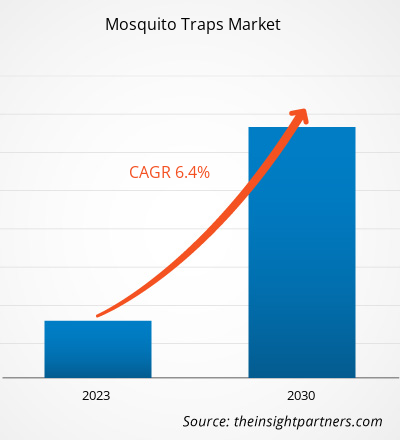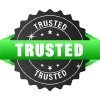[Research Report] The mosquito traps market size is expected to grow from US$ 364.62 million in 2022 to US$ 597.48 million by 2030; it is estimated to register a CAGR of 6.4% from 2022 to 2030.
Market Insights and Analyst View:
Mosquito traps are devices designed to attract and capture/kill mosquitos, offering a more environmentally friendly and targeted approach to mosquito control compared to traditional chemical insecticides. The market’s growth is primarily driven by increasing awareness of mosquito-borne diseases such as malaria, dengue, Zika virus, and chikungunya, which spurred the demand for effective mosquito control solutions. Additionally, concerns over the environmental impact of chemical insecticides have led consumers and governments to seek alternative solutions such as mosquito traps. Furthermore, advancements in technology and research have led to the development of more sophisticated and efficient mosquito traps, with features such as attractants mimicking human body odors and carbon dioxide to lure mosquitoes. This factor is significantly driving the global mosquito traps market growth.
Growth Drivers and Challenges:
Governments and public health organizations across the world are recognizing the significance of mosquito control to combat mosquito-borne diseases and protect public health. The initiatives by government and public health organizations include implementing mosquito control strategies, promoting the use of effective mosquito traps, and creating awareness regarding mosquito control methods. Governments of many countries have announced mosquito surveillance programs, with goals to monitor mosquito population and assess disease transmission risks. Furthermore, according to the World Health Organization, over 700 thousand deaths were recorded worldwide as of March 2020 due to diseases such as malaria, dengue, schistosomiasis, human African trypanosomiasis, leishmaniasis, Chagas disease, yellow fever, Japanese encephalitis, and onchocerciasis, generally spread by mosquitoes. The prevalence of mosquito-borne diseases differs as per the geographic location due to climate change, public health interventions, and vector control efforts. However, The availability of a wide range of alternatives or substitutes to mosquito traps offers customers a range of mosquito control options based on preferences and specific requirements. Chemical insecticides are available in various forms, such as sprays, coils, lotions, and repellents. Mosquito repellents generally contain active ingredients such as DEET (i.e., N, N-diethyl-meta-toluamide), picaridin, or natural oils—such as citronella, lemongrass, or eucalyptus. Larvicides are chemicals that target mosquito larvae to control mosquito breeding in stagnant water bodies. This factor hinders the demand for mosquito traps.
Customize This Report To Suit Your Requirement
You will get customization on any report - free of charge - including parts of this report, or country-level analysis, Excel Data pack, as well as avail great offers and discounts for start-ups & universities
Mosquito Traps Market: Strategic Insights

-
Get Top Key Market Trends of this report.This FREE sample will include data analysis, ranging from market trends to estimates and forecasts.
Report Segmentation and Scope:
The “Global Mosquito Traps Market” is segmented on the basis of product type, category, and distribution channel. Based on product type, the mosquito traps market is segmented into electric shock mosquito killer, photocatalytic mosquito killer, and sticky trap mosquito killer. By category, the mosquito traps market is segmented into outdoor and indoor. Based on distribution channel, the mosquito traps market is segmented into direct sales (direct offline sales and direct online sales) and retail sales (supermarkets & hypermarkets, specialty stores, online retail, and others). Geographically, the market is segmented into North America (the US, Canada, and Mexico), Europe (Germany, France, Italy, the UK, Russia, and the Rest of Europe), Asia Pacific (Australia, China, Japan, India, South Korea, and the Rest of Asia Pacific), the Middle East & Africa (South Africa, Saudi Arabia, the UAE, and the Rest of Middle East & Africa), and South & Central America (Brazil, Argentina, and the Rest of South & Central America).
Segmental Analysis:
Based on product type, the mosquito traps market is segmented into electric shock mosquito killer, photocatalytic mosquito killer, and sticky trap mosquito killer. The electric shock mosquito killer segment held the largest market share in 2022. Electric shock mosquito killer consists of an ultraviolet source or attraction mechanism, fan or suction mechanism, electric grid, collection tray, and safety features. Mosquitoes are zapped by electric charge resulting in immediate elimination in the electric grid trap. Electric shock mosquito traps are chemical-free, nontoxic, and long-lasting mosquito control option. Electric shock mosquito killer offers large coverage areas and can be installed in outdoor spaces and gardens. By category, the mosquito traps market is segmented into outdoor and indoor. The mosquito traps market share for the indoor segment was the largest in 2022. Mosquito traps are designed to capture and eliminate mosquitoes in indoor spaces, including residential buildings, offices, company corridors, public organizations, healthcare facilities, and educational institutes. The traps are safe and nontoxic alternative to chemical insecticides or repellents. Based on distribution channel, the mosquito traps market is segmented into direct sales (direct offline sales and direct online sales) and retail sales (supermarkets & hypermarkets, specialty stores, online retail, and others). The mosquito traps market share for the retail sales segment was the largest in 2022. Supermarkets and hypermarkets are large retail establishments that sell a wide range of products, including groceries, personal care, and household products. Smart arrangement and display of products in supermarkets and hypermarkets allow shoppers to find the right product quickly.
Regional Analysis:
Geographically, the mosquito traps market is segmented into five key regions—North America, Europe, Asia Pacific, South & Central America, and the Middle East & Africa. Asia Pacific dominated the global mosquito traps market share and accounted for over US$ 120 million in 2022. Asia Pacific is a major contributor to the global market. South & Central America is expected to register a considerable CAGR of around 4% from 2022 to 2030. The mosquito traps market in South & Central America is segmented into Brazil, Argentina, and the Rest of South & Central America. One of the major factors bolstering the market growth in this region is the increasing mosquito-borne diseases. Brazil has the highest number of dengue cases globally, with 3.2 million cases and 800 deaths reported during 2009–2014. The country has also been severely affected by outbreaks of Zika virus and chikungunya in the last few years. Thus, the increase in mosquito-borne diseases is expected to expand the mosquito trap market in the coming years. The Europe mosquito traps market is expected to reach over US$ 150 million by 2030.
Industry Developments and Future Opportunities:
Various initiatives taken by the key players operating in the mosquito traps market are listed below:
- In March 2023, COKIT introduced the latest toxin-free UV Light Insect Trap. The company is renowned for leveraging cutting-edge technology and the finest quality materials to produce state-of-the-art pest traps.
The regional trends and factors influencing the Mosquito Traps Market throughout the forecast period have been thoroughly explained by the analysts at The Insight Partners. This section also discusses Mosquito Traps Market segments and geography across North America, Europe, Asia Pacific, Middle East and Africa, and South and Central America.
Mosquito Traps Market Report Scope
| Report Attribute | Details |
|---|---|
| Market size in 2022 | US$ 364.62 Million |
| Market Size by 2030 | US$ 597.48 Million |
| Global CAGR (2022 - 2030) | 6.4% |
| Historical Data | 2020-2021 |
| Forecast period | 2023-2030 |
| Segments Covered |
By Product Type
|
| Regions and Countries Covered |
North America
|
| Market leaders and key company profiles |
|
Mosquito Traps Market Players Density: Understanding Its Impact on Business Dynamics
The Mosquito Traps Market is growing rapidly, driven by increasing end-user demand due to factors such as evolving consumer preferences, technological advancements, and greater awareness of the product's benefits. As demand rises, businesses are expanding their offerings, innovating to meet consumer needs, and capitalizing on emerging trends, which further fuels market growth.

- Get the Mosquito Traps Market top key players overview
COVID-19 Impact:
The COVID-19 pandemic affected almost all industries in various countries. Lockdowns, travel restrictions, and business shutdowns in North America, Europe, Asia Pacific (APAC), South & Central America (SAM), and the Middle East & Africa (MEA) hampered the growth of several industries, including the chemicals & materials industry. The shutdown of manufacturing units disturbed global supply chains, manufacturing activities, delivery schedules, and essential and nonessential product sales. Various companies reported delays in product deliveries and a slump in their product sales in 2020. Due to the pandemic-induced economic recession, consumers became cautious and selective in purchasing decisions. Consumers significantly reduced nonessential purchases due to lower incomes and uncertain earning prospects, especially in developing regions. Many manufacturers of mosquito traps faced declining profits due to reduced consumer demand during the initial phase of the pandemic. However, by the end of 2021, many countries were fully vaccinated, and governments announced relaxation in certain regulations, including lockdowns and travel bans. People started traveling to different places, which increased the demand for mosquito traps. All these factors positively impacted the growth of the mosquito trap market across different regions.
Competitive Landscape and Key Companies:
Woodstream Corp, Inzecto Corp, TNT Mosquito LLC, Novelty Manufacturing Co, Milo Enterprises Inc, Armatron International Inc, Kensizer Inc, Awoco, Shenzhen Tesenni Industrial Co Ltd, and Biogents AG are among the prominent players operating in the global mosquito traps market. These players offer high-quality mosquito traps and cater to many consumers in the global market.
Frequently Asked Questions
What is the largest region of the global mosquito traps market?
Based on the category, which segment is projected to grow at the fastest CAGR over the forecast period?
Based on product type, why the electric shock mosquito killer segment accounted for the largest revenue share in 2022?
What are the key drivers for the growth of the global mosquito traps market?
Can you list some of the major players operating in the global mosquito traps market?
What are the opportunities for mosquito traps in the global market?
- Historical Analysis (2 Years), Base Year, Forecast (7 Years) with CAGR
- PEST and SWOT Analysis
- Market Size Value / Volume - Global, Regional, Country
- Industry and Competitive Landscape
- Excel Dataset
Recent Reports
Testimonials
Reason to Buy
- Informed Decision-Making
- Understanding Market Dynamics
- Competitive Analysis
- Identifying Emerging Markets
- Customer Insights
- Market Forecasts
- Risk Mitigation
- Boosting Operational Efficiency
- Strategic Planning
- Investment Justification
- Tracking Industry Innovations
- Aligning with Regulatory Trends





















 Get Free Sample For
Get Free Sample For